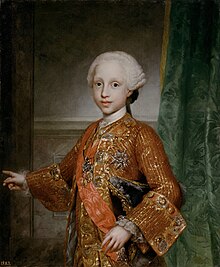Loading AI tools
Spanish infante From Wikipedia, the free encyclopedia
Infante Francisco Javier of Spain (15 February 1757 – 10 April 1771) was the youngest son of King Charles III of Spain and younger brother of King Charles IV of Spain and King Ferdinand I of the Two Sicilies.
| Infante Francisco Javier | |||||
|---|---|---|---|---|---|
 Portrait by Anton Raphael Mengs (Prado Museum) | |||||
| Born | 15 February 1757 Royal Palace of Caserta, Naples | ||||
| Died | 10 April 1771 (aged 14) Royal Palace of Aranjuez, Spain | ||||
| Burial | El Escorial, Spain | ||||
| |||||
| House | Bourbon | ||||
| Father | Charles III of Spain | ||||
| Mother | Maria Amalia of Saxony | ||||
Born in the Royal Palace of Caserta, he was baptized Francisco Javier Antonio Pascual Bernardo Francisco de Paula Juan Nepomuceno Julián of Naples and Sicily. His father was Charles VII, King of Naples and of Sicily since 1735. His mother was Maria Amalia of Saxony, daughter of Augustus III of Poland.
In 1759, on the death of his uncle King Ferdinand VI of Spain without children, his parents, his brothers Charles and Gabriel, and his sisters, Maria Luisa and Maria Josefa left for Spain where her father was crowned King Charles III of Spain.
Francisco Javier lost his mother one year later when he was three. He grew up at the Royal Palace of Aranjuez, but died of smallpox on 10 April 1771 at the age of 14.
He was buried at the El Escorial Monastery.[1]
| Ancestors of Infante Francisco Javier of Spain[2] | |||||||||||||||||||||||||||||||||||||||||||||||||||||||||||||||||||||||||||||||||||||||||||||||||||||||||||||||||||||||||||||||||||||||||||||||||||||||||||||||||||||||||||||||||||||||||||||||||||||||||||||||||||||||||||||||||||||||||||||||||||||||||||||||||||||||||||||||||||||||||
|---|---|---|---|---|---|---|---|---|---|---|---|---|---|---|---|---|---|---|---|---|---|---|---|---|---|---|---|---|---|---|---|---|---|---|---|---|---|---|---|---|---|---|---|---|---|---|---|---|---|---|---|---|---|---|---|---|---|---|---|---|---|---|---|---|---|---|---|---|---|---|---|---|---|---|---|---|---|---|---|---|---|---|---|---|---|---|---|---|---|---|---|---|---|---|---|---|---|---|---|---|---|---|---|---|---|---|---|---|---|---|---|---|---|---|---|---|---|---|---|---|---|---|---|---|---|---|---|---|---|---|---|---|---|---|---|---|---|---|---|---|---|---|---|---|---|---|---|---|---|---|---|---|---|---|---|---|---|---|---|---|---|---|---|---|---|---|---|---|---|---|---|---|---|---|---|---|---|---|---|---|---|---|---|---|---|---|---|---|---|---|---|---|---|---|---|---|---|---|---|---|---|---|---|---|---|---|---|---|---|---|---|---|---|---|---|---|---|---|---|---|---|---|---|---|---|---|---|---|---|---|---|---|---|---|---|---|---|---|---|---|---|---|---|---|---|---|---|---|---|---|---|---|---|---|---|---|---|---|---|---|---|---|---|---|---|---|---|---|---|---|---|---|---|---|---|---|---|---|---|---|---|
| |||||||||||||||||||||||||||||||||||||||||||||||||||||||||||||||||||||||||||||||||||||||||||||||||||||||||||||||||||||||||||||||||||||||||||||||||||||||||||||||||||||||||||||||||||||||||||||||||||||||||||||||||||||||||||||||||||||||||||||||||||||||||||||||||||||||||||||||||||||||||
Seamless Wikipedia browsing. On steroids.
Every time you click a link to Wikipedia, Wiktionary or Wikiquote in your browser's search results, it will show the modern Wikiwand interface.
Wikiwand extension is a five stars, simple, with minimum permission required to keep your browsing private, safe and transparent.